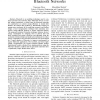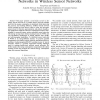IPPS
2007
IEEE
14 years 6 months ago
2007
IEEE
A heterogeneous multi-processor (HeMP) system consists of several heterogeneous processors, each of which is specially designed to deliver the best energy-saving performance for a...
IPCCC
2007
IEEE
14 years 6 months ago
2007
IEEE
LEACH (Low Energy Adaptive Clustering Hierarchy) [1] is one of the popular cluster-based structures, which has been widely proposed in wireless sensor networks. LEACH uses a TDMA ...
ICRA
2007
IEEE
14 years 6 months ago
2007
IEEE
Abstract Minimizing the energy consumption of target tracking using a mobile sensor network is proved to be NPcomplete. Based on proximity graph, an approximately optimal solution ...
ICPP
2007
IEEE
14 years 6 months ago
2007
IEEE
Extension of battery lifetime has always been a major issue for mobile computing. While more and more data are involved in mobile computing, energy consumption caused by I/O opera...
ICCCN
2007
IEEE
14 years 6 months ago
2007
IEEE
In the past decade cluster computing platforms have been widely applied to support a variety of scientific and commercial applications, many of which are parallel in nature. Howev...
ICC
2007
IEEE
14 years 6 months ago
2007
IEEE
Abstract— Bluetooth is an enabling technology used to construct personal area networks. Since Bluetooth devices are usually energy-constrained, a critical issue for Bluetooth net...
ICC
2007
IEEE
14 years 6 months ago
2007
IEEE
- Mobile sinks can be a viable solution to solve the problem that energy consumption is not balanced for all the sensor nodes in Wireless Sensor Networks (WSNs). Frequent location ...
GLOBECOM
2007
IEEE
14 years 6 months ago
2007
IEEE
Abstract—This paper presents a novel study on how to distribute neural networks in a wireless sensor networks (WSNs) such that the energy consumption is minimized while improving...
VTC
2008
IEEE
14 years 6 months ago
2008
IEEE
Abstract— Balancing energy consumption and prolonging network lifetime are open challenges in Wireless Sensor Networks. In this paper, we design a novel load balanced routing pro...
SECON
2008
IEEE
14 years 6 months ago
2008
IEEE
—The novel cross-layer protocol Breath for wireless sensor networks is designed, implemented, and experimentally evaluated. The Breath protocol is based on randomized routing, MA...



